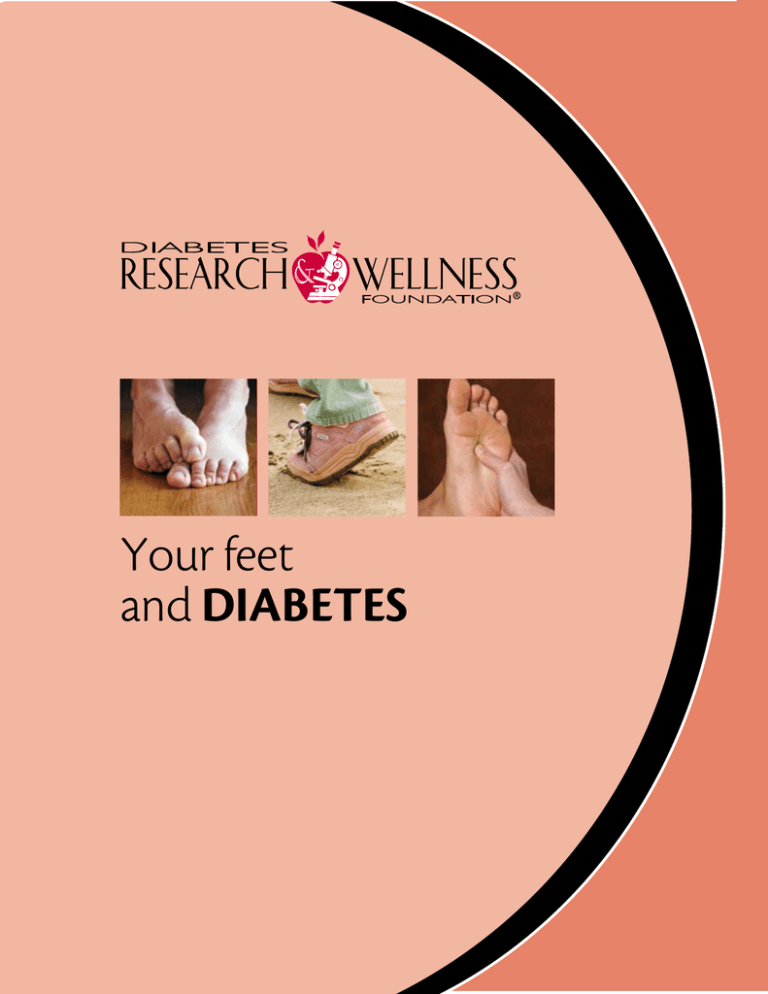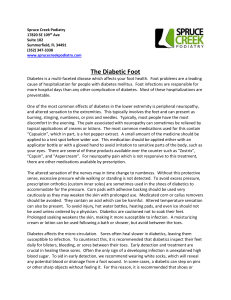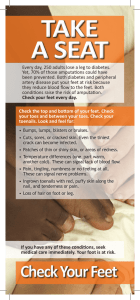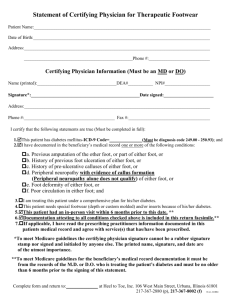
Your feet
and Diabetes
Neuropathy
Why are your feet so important?
Preventive care of your feet is very important if you have diabetes.
Individuals with diabetes are at risk for conditions that could result in an amputation. Diabetes is the primary cause of non-traumatic amputations.
How does diabetes affect my feet?
High blood sugars over the long-term may affect your blood vessels and nerves.
Especially susceptible are the nerves and blood vessels in your legs and feet.
There are three conditions that affect people with diabetes that may result in foot problems.
Neuropathy - damage to the nerves in the feet and legs
Vascular disease – narrowing of the blood vessels that supply food and oxygen to the feet and legs
Foot deformities – a change in the physical structure of the bones of the feet.
If you have any of these conditions, an infection or injury could cause a more serious problem.
••
•
Neuropathy
Neuropathy is damage caused by high blood sugars to the nerve endings. It can affect any nerve in the body, but is most commonly seen in the hands and feet. Individuals suffering from neuropathy may experience numbness or tingling in their feet; this
may progress to pain, and eventually a lack of any type of sensation. Individuals with neuropathy must be especially careful to
check their feet daily, since they may lose the ability to sense pain. Therefore, if your shoe is too tight and a blister develops, you
would not experience pain as a warning sign. Neuropathy may also cause the muscles that support the bones of the feet to be
weakened resulting in a change in the bone structure of the foot. Individuals with neuropathy may develop extremely dry skin
which can lead to a cracking, increasing the risk of infection and wounds. Keeping your blood sugar in good control can reduce
the risk of developing neuropathy.
Vascular disease
Elevated blood sugar levels over time affect all the blood vessels of the body. If the blood vessels going to your lower legs and
feet are narrowed, the circulation and blood flow will be impaired. This may cause pain, will impact your ability to fight infections, and may result in the swelling of your feet and legs. This risk is increased by smoking, high blood pressure, and elevated
cholesterol. If you have diabetes, it is important to work with your doctor to keep your A1C below 6.5, your blood pressure below 130/80, and your LDL cholesterol below 70. Walking will actually improve your circulation. So engaging in physical activity
is important in the management of your diabetes.
Foot deformity
Any change in the structure of your foot may affect the normal pressure distribution. These high areas of pressure may, over time, develop into a foot ulcer or wound. In an effort to protect your foot,
an area of high pressure may result in a thickening of the skin causing a corn or callus. These have
the potential to develop into an ulcer and should be checked by a podiatrist who specializes in the
care of diabetic feet. If you have a foot deformity, you may require a specially made shoe to reduce
the areas of pressure on your foot.
Trauma
When you have diabetes, a slight trauma may result in a more serious injury. Going barefoot, wearing
a shoe that is too tight, placing your foot in hot bath water may cause an injury. If you are unable to
sense pain, you may not be able recognize that your foot is injured.
Never try to treat corns or
hard skin yourself, see your
Podiatrist. If not treated
the pressure may lead to
ulceration.
vascular disease
Infection
If there is a crack or break in the skin, it is an opening for infection. An infection may develop into a
serious problem very rapidly. The signs of an infection include redness, swelling, pain, increased
temperature, and drainage of fluid. It is important that you contact your doctor the same day to
receive immediate treatment. You may be referred to a wound clinic. Diabetic foot ulcers are serious
and may take a long time to heal.
Athlete’s foot infections should be treated immediately so they do not develop into a more serious
infection. Over-the-counter ointments and powders may be used. Be sure to treat between the toes
and follow the directions for a full course of treatment in order to prevent a reoccurrence.
What should you expect from your health care provider?
When your diabetes is diagnosed, you should be given advice about foot and shoe
care. You should be given written information that you can keep at home to act as
a reminder and to which you can refer if a problem develops. Your feet should be
examined yearly by your health care provider. Remove your shoes at your doctor
appointment to ensure your feet will be inspected.
Your doctor should examine:
your skin for any evidence of sores, irritation or infection
the shape of your foot and evaluate for any deformities
the pulses in your foot
your ability to sense touch using a monofilament
your reflexes using a tuning fork
••
••
•
If any abnormalities are found, you should seek additional information regarding foot care and the need for special shoes. Some
problems may require referral to a podiatrist to reduce the risk of
trouble in the future.
If you are told you have neuropathy, you should ask to be referred
to a podiatrist that specializes in diabetes foot care. You should
have a podiatrist trim your nails. You may also be referred to a
pedorthist if you have feet that are so deformed you cannot find
shoes to fit properly. A pedorthist will make custom shoes to provide support and prevent any areas of pressure.
Overtly dry skin can lead to
deep cracks in the skin and
could lead to a foot ulcer
Staying healthy until a cure is found.
What should I look for when purchasing shoes?
Choose shoes with soft, cushioning insoles. A good quality athletic shoe can be ideal as they have soft, cushioning insoles
and they come in a wide variety of styles. If the insole is hard, there must be room to insert a soft insole. Avoid elastic
backings, they allow chafing movements of the foot within the shoe. Elasticized backs are particularly dangerous as
chafing injuries over the Achilles tendon are very difficult to heal.
Buy new shoes in the afternoon because feet swell as the day goes on. Check the fit, paying attention to length, width and
depth in the toe box. Your feet change shape when you stand up, so check for areas of tightness when standing as well as
sitting. Always break-in new shoes no matter how comfortable they feel.
Key points to remember
•
•
•
•
•
•
•
•
•
Inspect your feet daily. If you have poor eyesight, have someone else inspect them. If you are having difficulties examining your feet, place a mirror on the floor and hold your foot over the mirror. Look for corns, calluses, pressure areas,
cracks or blisters. Check between toes for athlete’s foot. If you find a problem, seek medical advice. Do not self-treat.
Feel inside your shoes before putting them on. You are looking for objects, wrinkled linings or insoles that can cause
irritation.
Do not walk barefoot; wear slippers if you have to get up at night.
Trim nails carefully after softening them by washing. Use an emery board to file them. Have your nails trimmed by a
podiatrist if you have neuropathy.
Apply a good quality, alcohol-free lotion to feet after washing and patting dry. Do not apply lotion between the toes.
Do not self-treat corns or calluses. These conditions should be treated by a podiatrist.
Check your socks and stockings for signs of wear.
Keep your shoes in good repair. Badly worn heels can alter your gait and cause abnormal pressure.
Choose a well-fitting, sensible shoe. High heels cause abnormal pressure on the ball of the foot, and open-toed shoes
offer no protection against accidental bumps. Limit the use of such shoes to special occasions; if you have neuropathy
or vascular disease, avoid such shoes altogether.
All rights reserved.
5151 Wisconsin Ave. NW, Suite 420 • Washington, D.C. 20016
www.diabeteswellness.net
Helpline Questions 1-800-941-4635 • Administrative offices 202-298-9211
An Organization for People Who Live with Diabetes Every Day.
The mission of Diabetes Research & Wellness Foundation (DRWF) is to help find the cure for diabetes, and until that goal is achieved, to
provide the care and self-management skills needed to combat the life-threatening complications of this terrible disease.
Thank you for your confidence in the programs and services that the Diabetes Research & Wellness Foundation® provides to the community.
Please designate us in the Combined Federal Campaign & United Way. Check box #11629.



